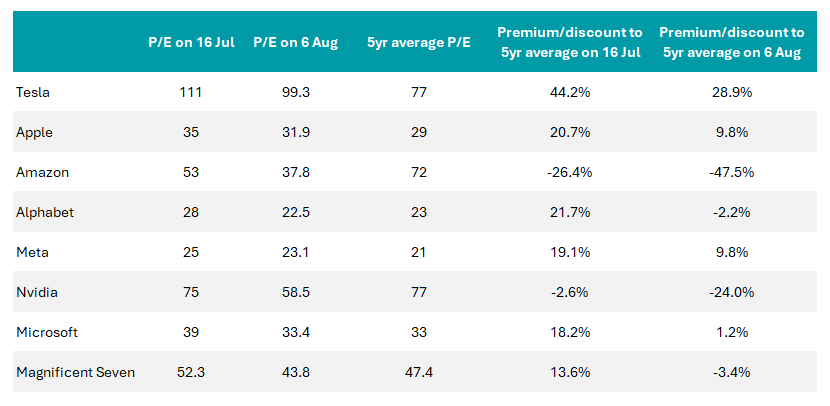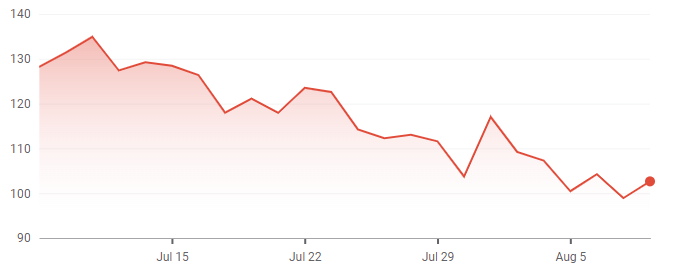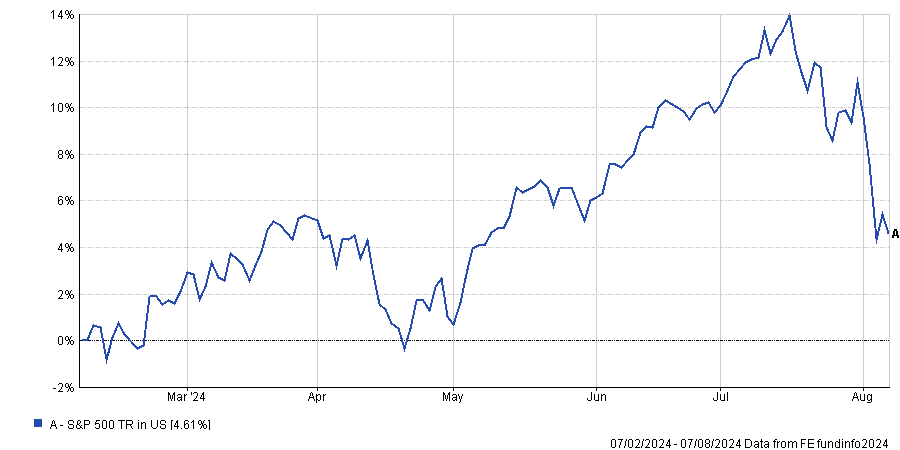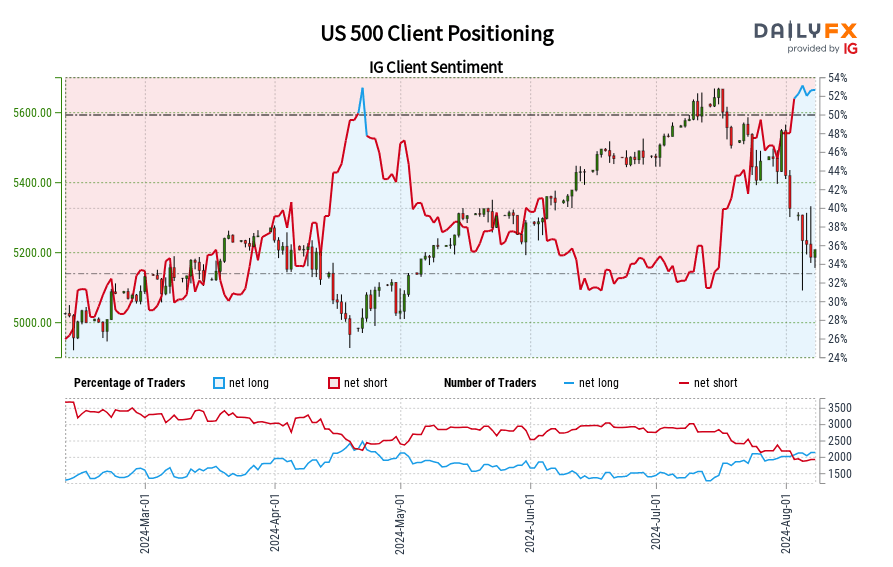The savage sell-off in technology stocks has hit the Magnificent Seven hard but now they are no longer priced for perfection, investors may be wondering whether this is a good time to pile back in.
Chris Beauchamp, chief market analyst at IG Group, believes that current market volatility is “a growth scare” and “probably not the beginning of something more dramatic”.
A reset was arguably needed, he continued, and now share prices are more attractive. “If you wanted to be in tech, now is a better time.”
In mid-July, the Magnificent Seven as a group were trading on 52x earnings – a 15% premium to their five-year average. By 6 August, valuations had fallen to a 3% discount versus their five-year average price-to-earnings (P/E) multiples, as the table below shows.
Magnificent Seven P/E ratios vs 5yr average

Sources: IG Group, Reuters Eikon
Amazon’s P/E ratio has slumped to almost half (47.5%) of its five-year average, while Nvidia’s P/E of 58.5x represents a 24% discount compared to its five-year average of 77x.
After months of gravity-defying gains, Nvidia’s share price slid from $134.91 on 10 July to $98.91 on 7 August – a $36 or 27% fall.
If he had told an investor two months ago that they would soon be able to buy Nvidia at today’s prices, they would have “bitten my arm off”, Beauchamp said.
Share price performance of Nvidia over 1 month

Source: Google Finance
Looking at the US stock market more broadly, Beauchamp thinks the recent falls should not cause panic. The less liquid summer months are usually a tricky period for markets and volatility is part and parcel of investing.
The S&P 500 has retreated to its May 2024 levels, wiping out a couple of months of gains which is “not cataclysmic” and perhaps volatility is “the price you pay” for the exponential returns earlier this year, he said. “We’ve been riding so far ahead of an average year, so there had to be a reckoning.”
Performance of S&P 500 over 6 months in dollar terms

Source: FE Analytics
Beauchamp thinks the US equity market to end the year above its current level but “we should expect the ride to be choppy from here.”
Judging by their trading activity, IG Group’s clients were net short US equities at the market’s mid-July peak but have been buying during the sell-off, he added.
IG Group clients’ exposure to the S&P 500

Source: IG Group
For Simon Webber, head of global equities at Schroders, the correction also came as no surprise. “We have been anticipating increased equity market volatility given the disconnect between buoyant consensus expectations, mixed economic data and an apparent mispricing of risk.”
He agreed with Beauchamp that equities have become a more attractive prospect following the sell-off. “The bottom line is that equity markets were vulnerable to a correction but company fundamentals are decent and heightened volatility is an opportunity for repositioning where dislocations occur,” he said.
“A soft landing for the economy remains our central scenario and we still expect equity markets to be well-supported in the medium term by modest growth in corporate earnings.”
Conversely, Franklin Templeton’s chief market strategist Stephen Dover warned that “the market moves may not yet have run their course”.
“Opportunity will eventually present itself, but we think it is too early for all but the most long-term investors to seek value,” he cautioned.
Timing the market is notoriously difficult, especially as the best days often come hot on the heels of the worst. As such, most stick with the tried and tested mantras of diversification and drip feeding, even – and perhaps especially – during volatile periods.
Rob Morgan, chief investment analyst at Charles Stanley, said: “At these times it is usually best to keep calm, stick to your investing plan and keep focused on the fact that sharp short-term moves should pale into insignificance over multiple years and decades. It’s rather like avoiding seasickness by keeping your eyes on the horizon rather than the rolling waves below.”
For anyone with cash on the sidelines who is thinking about investing but might be nervous about current market conditions, making regular contributions, perhaps at monthly intervals, is “one way to counter market ups and downs, as well as take some of the stress out of investing”, he said.
“The advantage of dripping money into the market is that you don’t need to worry about market timing. The strategy can even turn market volatility to your advantage as you average down if prices fall further.”





